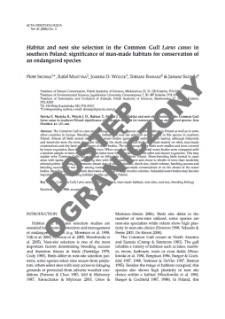
Obiekt
Tytuł: Habitat and nest site selection in the Common Gull Larus canus in southern Poland: significance of man-made habitats for conservation of an endangered species
Twórca:
Skórka, Piotr ; Martyka, Rafał ; Wójcik, Joanna D ; Babiarz, Tomasz ; Skórka, Janusz
Data wydania/powstania:
Typ zasobu:
Inny tytuł:
Współtwórca:
Museum and Institute of Zoology, Polish Academy of Sciences
Wydawca:
Museum and Institute of Zoology, Polish Academy of Sciences
Miejsce wydania:
Opis:
Typ obiektu:
Abstrakt:
The Common Gull is a rare and endangered breeding species at inland habitats in Poland as well as in some other countries in Europe. Breeding biology, habitat and nest site selection were studied in this species in southern Poland. Almost all birds nested on industrial water bodies (gravel pits, sedimentation basins), although fishponds and reservoirs were the most abundant habitat in the study area. Birds built their nests mainly on islets, man-made constructions and dry land on the shores of water bodies. The islets occupied by birds were smaller and were covered by lower vegetation than the unoccupied ones. When occupied islets on industrial water bodies were compared with a random sample of islets on fishponds, the latter were found to be larger, with taller and denser vegetation. This may explain why Common Gulls did not breed on fishponds in southern Poland. Shore-breeding birds nested in open areas with sparse vegetation, occupying sites with less vegetation cover and closer to shrubs or trees than randomly selected points. Breeding performance (mean date of clutch initiation, clutch size, clutch volume, hatching success and breeding success) did not differ among nests built on islets, man-made constructions or on the shores of the water bodies. Breeding success was more than twice as high as in large riverine colonies. Industrial water bodies may become important alternative breeding habitats for this species in Poland.
Czasopismo/Seria/cykl:
Tom:
Zeszyt:
Strona pocz.:
Strona końc.:
Szczegółowy typ zasobu:
Format:
Identyfikator zasobu:
Źródło:
MiIZ PAN, call no. P.257 ; MiIZ PAN, call no. P.4568 ; kliknij tutaj, żeby przejść
Język:
Język streszczenia:
Prawa:
Rights Reserved - Restricted Access
Zasady wykorzystania:
Lokalizacja oryginału:
Library of the Museum and Institute of Zoology of the Polish Academy of Sciences
Dostęp:
Kolekcje, do których przypisany jest obiekt:
- Repozytorium Cyfrowe Instytutów Naukowych > Kolekcje Partnerów > Muzeum i Instytut Zoologii PAN > Czasopisma
- Repozytorium Cyfrowe Instytutów Naukowych > Kolekcje Partnerów > Muzeum i Instytut Zoologii PAN > Wydawnictwa MiIZ PAN > Acta Ornithologica
- Repozytorium Cyfrowe Instytutów Naukowych > Piśmiennictwo > Czasopisma/Artykuły
Data ostatniej modyfikacji:
2 paź 2020
Data dodania obiektu:
15 cze 2018
Liczba pobrań / odtworzeń:
50
Wszystkie dostępne wersje tego obiektu:
https://rcin.org.pl./publication/75760
Wyświetl opis w formacie RDF:
Wyświetl opis w formacie RDFa:
Wyświetl opis w formacie OAI-PMH:
Obiekty Podobne
Skórka, Piotr Martyka, Rafał Wójcik, Joanna D
Kosiński, Ziemowit
Lu, Xin
Alabrudzińska, Jagna Kaliński, Adam Słomczyński, Robert Wawrzyniak, Jarosław Zieliński, Piotr Bańbura, Jerzy
Kędra, Aleksander H. Mazgajski, Tomasz D. Kowalczyk, Krzysztof
Murgui, Enrique
Antonov, Anton (1977–2012) Atanasova, Dimitrinka
Gokula, Varadhrajan

 INSTYTUT ARCHEOLOGII I ETNOLOGII POLSKIEJ AKADEMII NAUK
INSTYTUT ARCHEOLOGII I ETNOLOGII POLSKIEJ AKADEMII NAUK
 INSTYTUT BADAŃ LITERACKICH POLSKIEJ AKADEMII NAUK
INSTYTUT BADAŃ LITERACKICH POLSKIEJ AKADEMII NAUK
 INSTYTUT BADAWCZY LEŚNICTWA
INSTYTUT BADAWCZY LEŚNICTWA
 INSTYTUT BIOLOGII DOŚWIADCZALNEJ IM. MARCELEGO NENCKIEGO POLSKIEJ AKADEMII NAUK
INSTYTUT BIOLOGII DOŚWIADCZALNEJ IM. MARCELEGO NENCKIEGO POLSKIEJ AKADEMII NAUK
 INSTYTUT BIOLOGII SSAKÓW POLSKIEJ AKADEMII NAUK
INSTYTUT BIOLOGII SSAKÓW POLSKIEJ AKADEMII NAUK
 INSTYTUT CHEMII FIZYCZNEJ PAN
INSTYTUT CHEMII FIZYCZNEJ PAN
 INSTYTUT CHEMII ORGANICZNEJ PAN
INSTYTUT CHEMII ORGANICZNEJ PAN
 INSTYTUT FILOZOFII I SOCJOLOGII PAN
INSTYTUT FILOZOFII I SOCJOLOGII PAN
 INSTYTUT GEOGRAFII I PRZESTRZENNEGO ZAGOSPODAROWANIA PAN
INSTYTUT GEOGRAFII I PRZESTRZENNEGO ZAGOSPODAROWANIA PAN
 INSTYTUT HISTORII im. TADEUSZA MANTEUFFLA POLSKIEJ AKADEMII NAUK
INSTYTUT HISTORII im. TADEUSZA MANTEUFFLA POLSKIEJ AKADEMII NAUK
 INSTYTUT JĘZYKA POLSKIEGO POLSKIEJ AKADEMII NAUK
INSTYTUT JĘZYKA POLSKIEGO POLSKIEJ AKADEMII NAUK
 INSTYTUT MATEMATYCZNY PAN
INSTYTUT MATEMATYCZNY PAN
 INSTYTUT MEDYCYNY DOŚWIADCZALNEJ I KLINICZNEJ IM.MIROSŁAWA MOSSAKOWSKIEGO POLSKIEJ AKADEMII NAUK
INSTYTUT MEDYCYNY DOŚWIADCZALNEJ I KLINICZNEJ IM.MIROSŁAWA MOSSAKOWSKIEGO POLSKIEJ AKADEMII NAUK
 INSTYTUT PODSTAWOWYCH PROBLEMÓW TECHNIKI PAN
INSTYTUT PODSTAWOWYCH PROBLEMÓW TECHNIKI PAN
 INSTYTUT SLAWISTYKI PAN
INSTYTUT SLAWISTYKI PAN
 SIEĆ BADAWCZA ŁUKASIEWICZ - INSTYTUT TECHNOLOGII MATERIAŁÓW ELEKTRONICZNYCH
SIEĆ BADAWCZA ŁUKASIEWICZ - INSTYTUT TECHNOLOGII MATERIAŁÓW ELEKTRONICZNYCH
 MUZEUM I INSTYTUT ZOOLOGII POLSKIEJ AKADEMII NAUK
MUZEUM I INSTYTUT ZOOLOGII POLSKIEJ AKADEMII NAUK
 INSTYTUT BADAŃ SYSTEMOWYCH PAN
INSTYTUT BADAŃ SYSTEMOWYCH PAN
 INSTYTUT BOTANIKI IM. WŁADYSŁAWA SZAFERA POLSKIEJ AKADEMII NAUK
INSTYTUT BOTANIKI IM. WŁADYSŁAWA SZAFERA POLSKIEJ AKADEMII NAUK


































